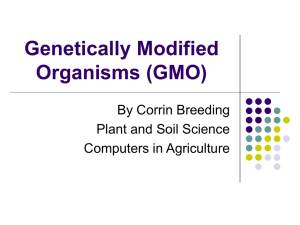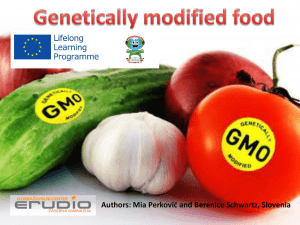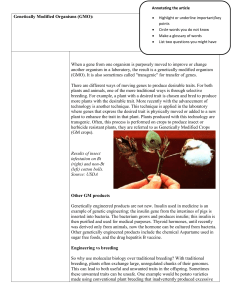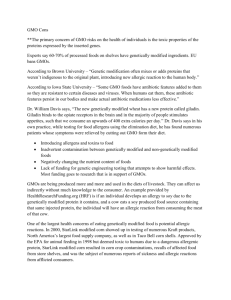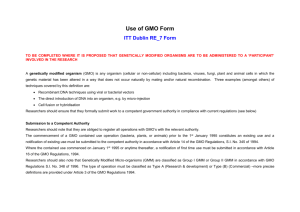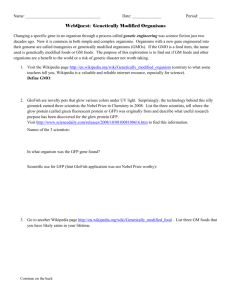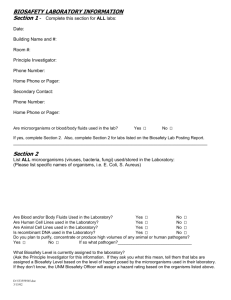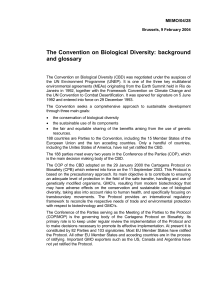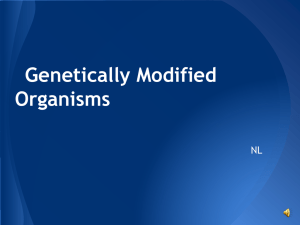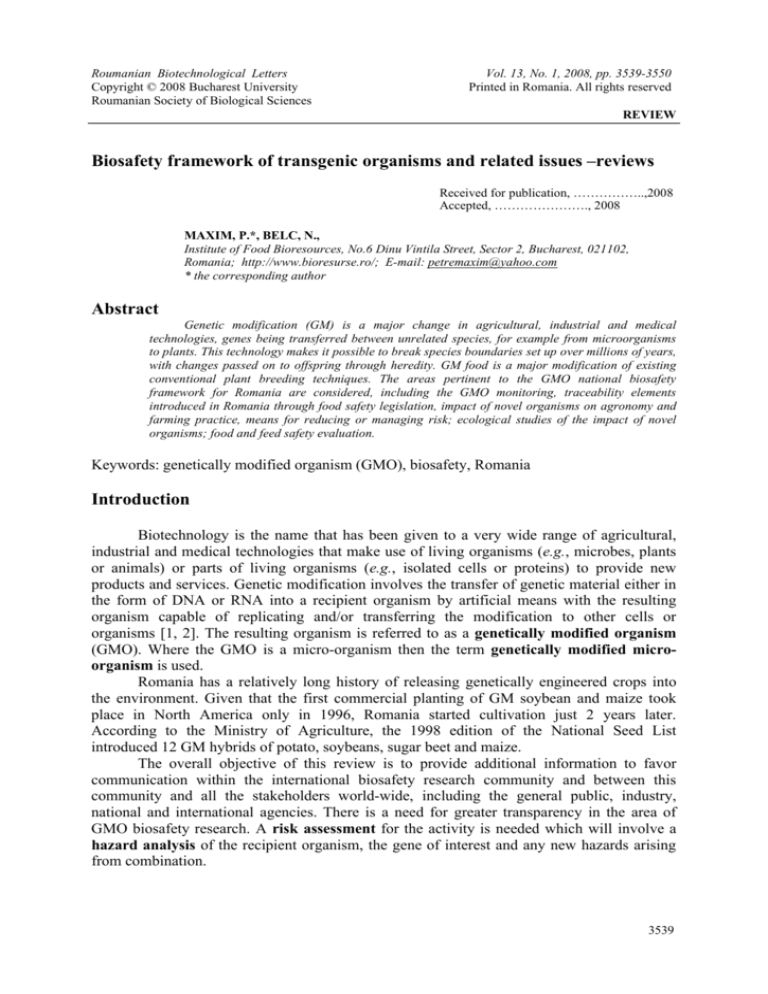
Roumanian Biotechnological Letters
Copyright © 2008 Bucharest University
Roumanian Society of Biological Sciences
Vol. 13, No. 1, 2008, pp. 3539-3550
Printed in Romania. All rights reserved
REVIEW
Biosafety framework of transgenic organisms and related issues –reviews
Received for publication, ……………..,2008
Accepted, …………………., 2008
MAXIM, P.*, BELC, N.,
Institute of Food Bioresources, No.6 Dinu Vintila Street, Sector 2, Bucharest, 021102,
Romania; http://www.bioresurse.ro/; E-mail: petremaxim@yahoo.com
* the corresponding author
Abstract
Genetic modification (GM) is a major change in agricultural, industrial and medical
technologies, genes being transferred between unrelated species, for example from microorganisms
to plants. This technology makes it possible to break species boundaries set up over millions of years,
with changes passed on to offspring through heredity. GM food is a major modification of existing
conventional plant breeding techniques. The areas pertinent to the GMO national biosafety
framework for Romania are considered, including the GMO monitoring, traceability elements
introduced in Romania through food safety legislation, impact of novel organisms on agronomy and
farming practice, means for reducing or managing risk; ecological studies of the impact of novel
organisms; food and feed safety evaluation.
Keywords: genetically modified organism (GMO), biosafety, Romania
Introduction
Biotechnology is the name that has been given to a very wide range of agricultural,
industrial and medical technologies that make use of living organisms (e.g., microbes, plants
or animals) or parts of living organisms (e.g., isolated cells or proteins) to provide new
products and services. Genetic modification involves the transfer of genetic material either in
the form of DNA or RNA into a recipient organism by artificial means with the resulting
organism capable of replicating and/or transferring the modification to other cells or
organisms [1, 2]. The resulting organism is referred to as a genetically modified organism
(GMO). Where the GMO is a micro-organism then the term genetically modified microorganism is used.
Romania has a relatively long history of releasing genetically engineered crops into
the environment. Given that the first commercial planting of GM soybean and maize took
place in North America only in 1996, Romania started cultivation just 2 years later.
According to the Ministry of Agriculture, the 1998 edition of the National Seed List
introduced 12 GM hybrids of potato, soybeans, sugar beet and maize.
The overall objective of this review is to provide additional information to favor
communication within the international biosafety research community and between this
community and all the stakeholders world-wide, including the general public, industry,
national and international agencies. There is a need for greater transparency in the area of
GMO biosafety research. A risk assessment for the activity is needed which will involve a
hazard analysis of the recipient organism, the gene of interest and any new hazards arising
from combination.
3539
MAXIM, P., BELC, N.,
WHAT IS PLANT BIOTECHNOLOGY?
Traditional plant breeding is a relatively slow and labour-intensive process: if two
parental plants are crossed, the seeds from them must be collected, planted and the resulting
plants cultivated before the results of the cross can be seen. Furthermore, plant breeders must
work with whole sets of inherited characteristics. Consequently, a cross to introduce a
desirable characteristic is likely to introduce one or more undesirable characteristics as well;
and these must then be painstakingly 'bred out' [3]. The techniques of biotechnology
(including genetic modification) can be used to speed up the process and improve the
precision of plant breeding compared with conventional methods such as random genetic
changes introduced by radiation [4].
“Genetic modification” is officially defined as the alteration of genetic material (DNA
or RNA) of an organism by means that could not occur naturally through mating and/or
recombination [5].
WHAT ARE THE MAIN CURRENT APPLICATIONS OF PLANT GENETIC
MODIFICATION?
The majority of current plant biotechnology is directed towards the improvement of
food plants; the remaining work is concerned with non-food crops such as cotton, tobacco,
ornamental plants and pharmaceuticals. The initial emphasis has generally been on the
improvement of qualities of value to the farmer. Most of this work has been initiated and
funded by the seed industry. The second and third generations of genetically-modified food
plants will bring benefits that more directly affect commerce.
The second and third generations of genetically-modified food plants will bring
benefits that more directly affect commercial food processors and consumers. Many
thousands of field trials of genetically-modified plants have been carried out world-wide [6].
Although several different modified crops are grown, only a handful of GM-derived
products have been approved for food use in the EU: processed soy derivatives such as
lecithin; oil from oil seed rape; processed tomato purée and maize. No fresh GM products
(such as tomatoes, potatoes or unprocessed soy beans) have been approved for human
consumption in the EU. The only GM crop currently grown to any extent (and then only in
limited amounts) in the EU is maize, which is produced for animal feed [7].
WHAT IS MICROBIAL TRANSFORMATION?
In the general context, work falling within the scope to involve the 'transformation' of
microorganisms, the introduction of DNA into microorganisms by 'artificial' means. This
almost always involves the use of plasmid DNA [8]. Plasmids are small rings of DNA
comprising just a few genes, that are found in bacteria and yeasts. They are not normally
essential for the microbes, but they may help them to survive in rare and exotic environments.
For instance, some plasmids enable the bacteria that carry them to resist the toxic effects of
heavy metals or antibiotics, or to live on particular nutrients. Sequences of DNA can be
'spliced' into plasmids, allowing them to be used as vectors for transferring genes between
organisms [9,10].
What is 'Self-cloning'?
Microbial transformation in which DNA (or RNA) is returned to a species in which it
could naturally occur is known technically (and rather confusingly) as 'self-cloning'. In this
context 'cloning' means making copies of plasmid DNA within an organism [11]. Because the
plasmids used are made entirely from DNA that could occur naturally within the species
3540
Roum. Biotechnol. Lett., Vol. 13, No. 1, 3539-3550 (2008)
Biosafety framework of transgenic organisms and related issues –reviews
involved, the work is called ''self-cloning'. The official definition of self-cloning runs as
follows:
" ... the removal of nucleic acid sequences from a cell ... followed by the re-insertion of
all or part of that nucleic acid ... into cells of the same species or into cells of phylogenetically
closely-related species with which it can exchange genetic material by homologous
recombination" [12].
In other words, if the transfer of genetic information is largely confined to that which
could naturally occur within a single species, the work is regarded as 'self-cloning'. The
nucleic acid may have been subject to modification by enzymatic, chemical or mechanical
steps so as to produce a novel order of genes / bases, to remove sequences, to produce
multiple gene copies, etc.
Self-cloning, where the resulting organism is unlikely to cause disease in humans,
animals or plants, is exempt from the 'Contained Use' regulations. Schools and others may
undertake such work without licensing their premises or setting up a GMSC. However,
somewhat unusually (since these microbes could in theory be found in nature) the organisms
produced are covered by the 'Deliberate Release' regulations.
WHAT IS CONTAINMENT?
Under current legislation it is an offence to release any GMO into the environment or
to allow it to escape without prior consent. It is therefore essential that even 'self-cloned'
organisms and adequately contained and that a 'release' does not occur. A key point is that an
accidental release of a GMO might be considered to be deliberate if the steps taken to ensure
containment are deemed to have been inadequate. If a GMO cannot survive in, or transmit
genes to other organisms in the environment, it is regarded as being 'biologically contained',
and an accidental escape is not regarded as a 'release' [13]. Containment can be ensured
simply by following good microbiological practice and good occupational safety and hygiene,
coupled with the careful selection of suitable host organisms and plasmids [14]. This would
usually involve, for example, using host strains that are weakened and 'non-mobilisable'
plasmids that cannot transfer their genes into the host's chromosome, or be transferred into
other organisms by natural means such as bacterial conjugation.
It is important to distinguish between contained use of transgenic organisms and their
release to the environment. Contained use occurs inside a physical facility designed to
prevent escape into the open environment. It can be controlled, in principle, and made as safe
as possible (though the current regulation of contained use is far from adequate). Release of
transgenic organisms to the environment, by contrast, cannot be controlled nor recalled, which
is why great care must be taken in advance of release.
The production of transgenic varieties – which features most prominently in genetic
engineering agriculture – is a new departure from conventional techniques including selective
breeding, mutagenesis (induction of gene mutations by chemical or physical means such as Xrays), cell fusion and tissue culture 15]. It raises safety concerns different in kind from those
of conventional techniques, and which are inherent to the processes used in creating
transgenic organisms. Typically, genes of one or more donor-species are isolated, and spliced
into artificially constructed infectious agents, which act as vectors to carry the genes into the
cells of recipient species. Once inside a cell, the vector carrying the genes will insert into the
cell's genome. A transgenic organism is regenerated from each transformed cell (or egg, in the
case of animals) which has taken up the foreign genes. And from that organism, a transgenic
variety can be bred. [16, 17]. In this way, genes can be transferred between distant species
which would never interbreed in nature.
Roum. Biotechnol. Lett., Vol. 13, No. 1, 3539-3550 (2008)
3541
MAXIM, P., BELC, N.,
The artificial vectors are typically made by joining together parts of the genomes of
natural viruses that cause diseases and other genetic parasites, plasmids (pieces of usually
circular DNA found in bacteria and yeasts, replicating independently of the chromosome(s))
and transposons (mobile genetic elements, or 'jumping genes' found in all species), which
carry and spread genes for antibiotic and drug resistances, as well as genes associated with
diseases. Most, if not all of the disease-causing genes will have been removed from the
artificial vectors, but antibiotic resistance genes are often left in as 'selectable markers', so
those cells which have taken up the foreign genes can be selected with antibiotics. While
natural viruses and other genetic parasites are limited by species barriers to varying degrees,
the artificial vectors made by genetic engineers are especially designed to cross species
barriers and to overcome mechanisms in the cell that destroy or inactivate foreign DNA [18].
The foreign genes are typically introduced with strong genetic signals, promoters
and/or enhancers, which enable the foreign genes to be expressed at very high levels
continuously (or constitutively), effectively placing those genes outside the normal metabolic
regulation of the cell, and of the transgenic organism resulting from the transformed cell. The
most common promoter used in plants is from the cauliflower mosaic virus (CaMV) [19].
WHAT ARE HOST STRAINS?
The bacterium species that is most commonly-used for cloning work is Escherichia
coli, strain K12. Unlike the wild type, K12 strains of E. coli are usually unable to inhabit the
mammalian gut. This strain's origins can be traced back to work in the USA in 1922.
Biochemical and genetic studies by Edward Tatum in the 1940s made the strain popular with
researchers, and after many millions of generations of laboratory cultivation, it is now known
to have undergone significant changes. These have altered the lipopolysaccharides that
comprise the outer membrane of the bacterial cell, so that it can no longer infect mammals.
Many strains of E. coli K12 have been specially-selected for transformation work. Usually
these do not harbor any extra-chromosomal DNA of their own, but can be transformed
efficiently by plasmids. Compared to the wild type E. coli, these 'cloning strains' are severely
weakened and would find it difficult to thrive outside the laboratory. They may have unusual
nutritional requirements, and are often susceptible to damage e.g., from the ultraviolet
component of sunlight [20].
Plasmids can pass from one bacterial cell to another of the same or a related species by
a natural 'mating' process called conjugation. During conjugation, a tube or pilus is formed
between adjacent cells, through which the plasmid passes. The genes required for the
formation of the pilus are also carried on a plasmid (an F or fertility plasmid). Host strains
used for transformation experiments in schools usually have no F plasmid, so that they cannot
pass on genetic material by conjugation. They often also lack phages, so that DNA cannot be
picked up and passed on by viral infection (transduction). The use of non-conjugative strains
of bacteria that lack phages, coupled with the use of non-mobilisable plasmids, significantly
reduces the risk of DNA being transferred between microorganisms, and hence the unwanted
transfer of characteristics such as antibiotic resistance.
The transformation of bacterial cells with plasmid DNA is very inefficient, and only a
small proportion of the cells treated will take up the DNA. Therefore a means of selecting
those cells that have been transformed is needed. The incorporation of one or more antibioticresistance genes into the plasmid DNA used to transform cells is the commonest method of
achieving this. In the presence of appropriate antibiotics, such plasmid-bearing cells thrive
while their less well-endowed (untransformed) neighbors perish. In this way, selection
3542
Roum. Biotechnol. Lett., Vol. 13, No. 1, 3539-3550 (2008)
Biosafety framework of transgenic organisms and related issues –reviews
pressure is applied to maintain the plasmid in the population of cells. Without that pressure,
the few transformed cells would be swamped by their untransformed neighbors.
Missing genes
For a plasmid to travel through a pilus, two additional requirements must be met. The
plasmid must possess a gene encoding a mobility protein (mob) and have a nic site. The
mobility protein nicks the plasmid at the nic site, attaches to it there and conducts the plasmid
through the pilus. Plasmids for demonstration experiments usually have neither a nic site nor
the mob gene. This means that once it has been introduced into a bacterial cell by artificial
means (transformation) a plasmid cannot naturally transfer (by conjugation) into other cells
that do not posses it.
Incubation at 37 °C
The delicate strains of E. coli used for cloning work often require incubation at 37 °C
for speedy growth. Good microbiological practice, coupled with the use of selective growth
media will ensure that contaminating human pathogens are not inadvertently cultivated at this
temperature.
Physical and chemical containment
In addition to the biological containment measures described above, good
microbiological practice must be followed to ensure that the microorganisms are physically
contained during the investigation and destroyed afterwards. The law requires that
genetically-modified microorganisms must be inactivated after use by a validated means. In
practice, this means that any cultures must be destroyed by autoclaving them. The
containment and the destruction of cells when such work is undertaken will prevent the spread
of antibiotic-resistant populations. In addition, most of the antibiotics used for such work are
heat-labile and readily break down when media are autoclaved after use. Together, these
methods of physical, chemical and biological containment will ensure that educational
exercises demonstrating the principles of genetic modification are as safe as possible [21].
WHAT IS THE NATIONAL BIOSAFETY FRAMEWORK FOR ROMANIA?
Romania is facing backbreaking decisions on aligning its agricultural legislation to the
EU's and applying it wherever possible. A short look over all notifications submitted on
GMOs on EU territory (http://gmoinfo.jrc.it/gmp_browse.aspx) shows most come from US
corporations such as Monsanto, Pioneer and Syngenta. Several other local players – state
universities (e.g. USAMV Timisoara) and companies covering national territories alone – are
also profiled, but in a much lesser measure. Pioneer, Monsanto and Syngenta have submitted
documents asking to test GM crops in Romania. If applied, the groups may start putting up
crops for testing GM soy, corn and plum trees. Recently, a maize hybrid, submitted for EU
approval by U.S. biotech company Monsanto, is known as MON810/NK603. The second
GMO maize, a hybrid known as 1507/NK603, is made jointly by Pioneer Hi-Bred
International, a subsidiary of DuPont Co., and Dow AgroSciences unit Mycogen Seeds.
Pioneer and Mycogen also submitted an application for a third GMO, a maize known
commercially as Herculex RW and also by the code number 59122.
They're also claiming that food is already insufficient and that "a solution to this crisis
is the use of biotechnology in agriculture", as Clive James put it during a Bucharest
conference on March 2, 2007
Romania was one of the first countries in Eastern Europe that put in place its national
biosafety framework. In this context, at the end of the year 1999, the Government Ordinance
49/2000 (GO) on the obtaining, testing, use and commercialization of genetically modified
Roum. Biotechnol. Lett., Vol. 13, No. 1, 3539-3550 (2008)
3543
MAXIM, P., BELC, N.,
organisms obtained through the modern biotechnology techniques, and of the products
resulting thereof, was issued. Two years later, Law no. 214/2002 for the approval of the GO
no. 49/2000, with modifications and completions, was promulgated, which at the same time
also largely transposed the following Directives: 90/219/EEC, 98/81/EEC and 2001/18/EC.
Romania signed on 11 October, 2000, as a Party to the Convention on Biological Diversity,
the Cartagena Protocol on Biosafety, which was ratified on 30 June, 2003 by the Law no.
59/2003. The Protocol entered into force on 28 September, 2003, thus Romania had to
implement all its provisions and it was expected that before Romania's accession to EU, all
EU biosafety regulatory provisions to be transposed in the national legislation. Now, in the
post-accession period, new legal acts will be prepared to amend and complete Law 214/2002
addressing other specific Romanian Biosafety Regulatory Systems. At present, new
regulations are to be enforced in order to strengthen the National Biosafety Framework (NBF)
in accordance with EU Biosafety Policy and the main international instruments in the field to
which Romania is a signatory Party.
The current Romanian Government Programme 2005-2008 briefly underlines the
development policy and strategy throughout its 27 chapters. Chapter 18 of the Governmental
Programme 2005-2008 focuses upon the Environmental Protection Policy of the Ministry of
Environment and Water Management. It can be considered that one of the main concerns of
Romanian Environmental Policy is biosafety, underlining the importance of implementing the
provisions of the Cartagena Protocol on Biosafety to the CBD. At the same time, it imposes
complying with the provisions of other international conventions with significant impact upon
the conservation of genetic resources and ensuring an adequate level of environment and
human health protection.
Romania has great concerns in preserving its natural resources as it is well known that
it is possessing one of the richest biodiversity in the region, therefore, this status is supported
by the numerous conventions and international Protocols, as well as bilateral and multilateral
agreements signed by Romania. Having as main objectives, strengthening the administrative
structures, as basic element to build a solid system of environment management and the
contribution to a durable development, the activity of Romanian Government will rely on the
following biosafety priorities:
1. Improvement in the quality of environment agents within urban and rural areas, in
this context, several objectives are mentioned in relation to the management of chemical
substances, the monitoring of the genetically modified organisms and the forbidding use of
those substances that represent a threat for the population health on Romania' s territory, as
follows: [i] Developing the Biosafety National Framework in order to implement the
Cartagena Protocol (Law 59/2003); [ii] Assuring the legislative framework upon the transport
cross border of genetically modified organisms, labeling and traceability of food and feed
products obtained from genetically modified organisms; [iii] Constituting a national
Catalogue of genetically modified organisms accepted on Romanian territory, accessible to
population; [iv] Creating and developing the laboratories specialized in detecting the
genetically modified organisms; [v] Participating at the Mechanism upon the Information
Exchange within the Biosafety field (Biosafety Clearing-House); [vi] transposing and
implementing the legislation on risk assessment and risk control of hazardous chemicals on
human health and the environment.
2. Extension of the national network of protected areas and natural reservations,
rehabilitation of the coast infrastructure of the Romanian seaside, economic and ecological
resizing of the Danube Delta;
3. Strengthening the cross-border and international partnership with similar
institutions from other countries in order to monitor the implementation stage of international
3544
Roum. Biotechnol. Lett., Vol. 13, No. 1, 3539-3550 (2008)
Biosafety framework of transgenic organisms and related issues –reviews
agreements by: [i] Signing Conventions, Agreements, Bilateral and multilateral Cooperation
within the field of Environment protection at European and world level for the purpose of
capitalizing the opportunities and facilities of institutional and financial technical financial
assistance and identifying some possibilities to finance the environment reconstruction
projects; [ii] Observing the notice and reporting requests undertaken by Romania as part
within different Conventions, Protocols and International Agreements; [iii] Assuring the
institutional framework established through different bilateral and multilateral agreements, for
the purpose of assuring the implementation of conventions that settle the cross-border
pollution, its prevention and reducing;
4. Strengthening the partnership with NGOs, in the process of elaboration and
enforcement of public policies within the field, by [i] Implementation of the Aarhus
Convention requests upon access to information, public participation in decision making and
access to justice within the environment issues, by concluding the legislative framework,
introduction of an informed system at central, regional and local level, upon management of
environment information; [ii] Media coverage of some punctual environment protection
issues: GMO-Genetically Modified Organisms, POPs-Persistent Organic Pollutants, PCBsPolychlorinated Biphenyls, climatic changes, in order to protect not only the environment but
also people health from the damaging effect of these substances.
GMO MONITORING ACTIVITY IN ROMANIA
GMO import, release into the environment and placing on the market, as well as
contained use are followed by specific biosafety activities. One of these activities is the
monitoring of GMO effects on the environment and human health and the identification of
unforeseen effects not identified during the risk assessment studies. In accordance with GO
no. 49/2000, approved with modifications and completions by Law 214/2002, GMO activities
will be subjected to the monitoring procedure with regard to the potential adverse effects on
human health and environment. The monitoring will follow certain procedures, clearly
stipulated in the law, according to a monitoring plan presented by the Notifier; the scientific
information obtained as a result of the application of this procedure will be used for future
risk assessment procedures as regards the placing on the market of the same GMO. The
monitoring activity can be carried out for contained use and/or after obtaining the approval for
GMO release into the environment or placing on the market. The data collected as a result of
the monitoring process should provide new information on the impact of GMO release into
the environment or on the market, under different conditions. When such new information
appears, this should be automatically considered when carrying out the following
environmental risk assessment studies. The experience and information collected through the
monitoring of GMO for deliberate release in the environment should be the basis for the
design of the monitoring system for placing on the market, as such or under the form of
different products. The objectives of the monitoring plan stipulated by the law 214/2002 are
according to Directive 2001/18/EC: (1) to confirm that assumptions in the environmental risk
assessment regarding the occurrence and impact of potential adverse effects of the GMO or its
use were correct; (2) to identify the occurrence of adverse effects of the GMO or its use on
human health and the environment that were not anticipated in the environmental risk
assessment.
According to the Law, the design of the monitoring plan have comply with Directive
2001/18/EC and these requirements are as follows: (1) be detailed on a case by case basis
taking into account the results of the environmental risk assessment (ERA); (2) take into
account the characteristics of the GMO, the characteristics and scale of its intended use and
the range of relevant environmental conditions where the GMO is expected to be released; (3)
incorporate general surveillance for unanticipated adverse effects and, if necessary, (case-)
Roum. Biotechnol. Lett., Vol. 13, No. 1, 3539-3550 (2008)
3545
MAXIM, P., BELC, N.,
specific monitoring focusing on adverse effects identified in ERA; [i] whereas case-specific
monitoring should be carried out for a sufficient time period to detect immediate and direct as
well as, where appropriate, delayed or indirect effects which have been identified in ERA; [ii]
whereas surveillance could, if appropriate, make use of already established routine
surveillance practices such as the monitoring of agricultural cultivars, plant protection, or
veterinary and medical products. An explanation as to how relevant information collected
through established routine surveillance practices will be made available to the consent-holder
should be provided; (4) facilitate the observation, in a systematic manner, of the release of a
GMO in the receiving environment and the interpretation of these observations with respect to
safety to human health or the environment; (5) identify who (notifier, users) will carry out the
various tasks the monitoring plan requires and who is responsible for ensuring that the
monitoring plan is set into place and carried out appropriately, and ensure that there is a route
by which the consent holder and the competent authority will be informed on any observed
adverse effects on human health and the environment. Time points and intervals for reports on
the results of the monitoring shall be indicated); (6) give consideration to the mechanisms for
identifying and confirming any observed adverse effects on human health and environment
and enable the consent holder or the competent authority, where appropriate, to take the
measures necessary to protect human health and the environment.
The Ministry of Environment and Water Management (MEWM) Order no. 606/2005
approves the Format for presenting the results of deliberate release into the environment of
genetically modified crops, for other purposes than placing on the market. As it has been
mentioned the Order fully transposes the Commission Decision no. 2003/701/EC, based on
Directive no. 2001/18/EC. Clear procedures are specified: (1) the Notifier submits a final
report or a final and intermediary report on post-release monitoring, according to each case.
Both types of reports are elaborated in accordance with the Report Format;
(2) the final report can be transmitted after the last harvesting of genetically modified crops. If
for a notification no post-release monitoring is required, no subsequent reports are needed;
(3) the final post-release monitoring report is submitted after the completion of the postrelease monitoring.
GMOs labelling and traceability are other important elements of the “follow up” phase
of a biosafety system. The main legal act that covers these activities is GO no. 49/2000,
approved with modifications and completions by Law 214/2002. The foodstuffs on the market
that are based on GMOs or that contain additives and flavours that have been genetically
modified or obtained from GMOs, is currently regulated by the GD 106/2002, Appendix no.
3, initiated by the National Authority for Consumer Protection (in this case the Minister of
Environment and Water Management has no responsibilities in this field). The label should
clearly specify whether GMOs are present. It is compulsory that the label should clear
specify: “This product contains genetically modified organisms”. GD106/2002 on food
labelling, stipulates in Appendix no.3 the Methodological Norms on additional information
that should be compulsory specified by labelling in the case of food obtained from GMOs or
that contains genetically modified additives and flavours that are obtained from GMOs. This
refers to foodstuffs or food ingredients that are fully or partly obtained from genetically
modified soybeans, tolerant to glyphosate and to genetically modified maize, tolerant to
ammonium glufosinate. The line “product obtained from genetically modified………” will be
clearly specified on the foodstuff label or in the list that specifies the ingredients. The
products containing more than 0.9 % GMOs will be labeled, complying with the EU
regulation. Foodstuffs and food ingredients should not be labelled, according to this decision
if they do not contain protein and/or DNA of GMO (i.e. oil, alcohol, starch). Traceability may
be achieved only through appropriate labelling throughout the chain for example GMO from
the laboratory to plant breeders, to seed producers, to farmers, processors, and
3546
Roum. Biotechnol. Lett., Vol. 13, No. 1, 3539-3550 (2008)
Biosafety framework of transgenic organisms and related issues –reviews
importer/exporters. It will be effective after transposing the Regulation 2003/1830/EC and by
ensuring the means of GMO detection and analysis. This responsibility lies with to the
National Sanitary-Veterinary and Food Safety Authority (NSVFSA) that will collaborate with
the MEWM, the Ministry of Agriculture, Forests and Rural Development (MAFRD), the
National Authority for Consumer Protection (NACP) and the Ministry of Health (MH). The
transposing deadline, established by the Position Document, was the second semester of 2006.
Certain traceability elements have already been introduced by Art. 29, par. 1(c) of the GO
49/2000, approved with modifications and completions by Law no. 214/2002, referring to
labelling and packaging.
Traceability elements have been also introduced through the MAFRD Order no.
462/2003 regarding the evidence of farmers cultivating GMO crops. It is specified that in the
approval process regarding the deliberate release into the environment and placing on the
market of GMO crops in the year 2005, MAFRD approved the GMO imports and deliberate
release in the environment for testing or cultivation purposes, only on the condition of
complying with the provisions of Order 462/2003, by all the economic operators cultivating
GMO crops.
The MAFRD, on the basis of this Order, is the competent national authority for the
evidence of economic operators that cultivate GMOs. The Order stipulates that it is
compulsory for all economic operators (natural or legal persons, non-legal associations) to
declare GMOs cultivated plots with and the yields obtained to the County Directorates for
Agriculture and Rural Development (CDARD), and to the Directorate of Bucharest
Municipality. The statement is filled in two copies: one copy is to be sent to the CDARD in
10 days maximum after the crop cultivation is completed (Appendix 1), after the crop
harvesting (Appendix 2); and another copy is kept at the central office of the economic
operator for 5 years. Information are collected at the CDARD and electronically transmitted
to the Computing Centre of MAFRD (the Record Register of Romanian Economic Operators
Cultivating GMO crops). In order to ensure the observance of the Order no. 462/2003 of the
MAFRD, the companies provide their clients with the statement Templates, together with the
seed selling documents that they have to fill in and send to the Agricultural Directorates. At
the same time, the companies should provide information to the MAFRD referring to the
client identification data, sold seed quantities, varieties and biological categories. This
information is necessary for checking the data received through the Agricultural directorates.
According to Law no. 266/2002, seeds can be imported only after receiving the import
approval issued by the MAFRD. The commodity is packed into bags, and on the labels and
accompanying documents it should be specified that the variety is genetically modified. For a
clear record regarding of the seed distribution, the clients are obliged to return the empty
packages to the respective companies, after the cultivation season. The MAFRD can forbid
the use of a GMO variety in a certain region of the country or on the whole territory, if it is
found that the respective variety is harmful for other crop varieties (i.e. outcross pollination)
or it endangers the environment or human health. A genetically modified variety cannot be
tested or registered if the applicant does not prove that this complies with the legal conditions
regarding environment and human health protection. So far, a proper record of the imported
quantities of GMO soybean for processing purposes could not be kept, as there is no distinct
tariff line in the Import Schedule for the genetically modified products. It is necessary to
establish, together with the NCA, a recording system. In the same context, the MAFRD,
together with the NSVFSA, imposed to the notifying companies the obligation to report the
accurate situation of cultivated areas, of the yield obtained and of its use to the MAFRD.
Other traceability elements were also introduced in Romania through food safety
legislation, namely Law no. 412/2004 for the modification and completion of Law no.
150/2004 on food safety. This law provides for checking the means by which feed traceability
Roum. Biotechnol. Lett., Vol. 13, No. 1, 3539-3550 (2008)
3547
MAXIM, P., BELC, N.,
is carried out by all the operators and agents in the food industry. On this basis, for the year
2005, the notifications of GMO producing companies, regarding GMO imports and deliberate
release into the environment for testing as well as for cultivation purposes were approved only
on the following condition: the economic operators, authorized natural or legal persons
operating in this field, should demonstrate the destination of the GMO seeds, up to the point
of their commercialization of GMO as food or feed. At the same time, the labelling of
products was imposed. The users of GMO seeds are to be informed by notifiers on the
obligations they have in traceability and labeling.
WHEN IS SCIENTIFIC EVIDENCE 'SUFFICIENT'?
When is scientific evidence considered sufficient to indicate that the risk is
unacceptable? There are four special safety concerns arising from current transgenic
technologies:
1. Effects due to the exotic genes and gene products introduced into the transgenic organisms.
2. Unintended, unexpected effects of random gene insertion and interaction between foreign
genes and host genes in the transgenic organisms.
3. Effects associated with the nature of the gene-constructs inserted into the transgenic
organisms.
4. Effects of gene flow, especially secondary, horizontal spread of genes and gene-constructs
from the transgenic organisms to unrelated species.
Risk is technically the extent of damage multiplied by the probability that the damage
will occur. People take risk for a number of reasons: because they have to, or because there is
overwhelming moral imperative for doing so, or because the likely benefits are compelling
despite the potential damage. That is in accordance with the generally accepted precautionary
principle [20, 21].
Conclusions
Developments in genetics and biotechnology over the last 50 years have culminated in
the genetic modification of living organisms to produce crops, trees, animals and
microorganisms with novel characteristics. Romania has great concerns in preserving its
natural resources as it is well known that it is possessing one of the richest biodiversity in the
region, therefore, this status is supported by the numerous conventions and international
Protocols, as well as bilateral and multilateral agreements signed by Romania. While some
products of biotechnology, including genetically modified organisms (GMOs), could be
designed to enable more environmentally sustainable management practices, the release of
GMOs may pose a number of risks to human and animal health and the environment. The
National Biosafety Framework for Romania in an undergoing improvable process.
References
1. National Biosafety Framework for Romania Draft, 2006, Ministry of Environment and
Water Management, Romania.
2. Hagiwara, K.; Higashi, T.; Takahashi, K.; Hara, N.; Aoki, H.; Miyazaki, N.; Wang
QingYu; Zhu YaFeng; Yatou, O.; Tanaka, H.; Omura, T. (2006). In vitro but not in planta
encapsidation of Rice gall dwarf virus core particles by the outer capsid P8 protein of Rice
dwarf virus expressed in transgenic rice plants. Journal of General Plant Pathology vol. 72
(3) p.186-189 Publisher: Springer-Verlag Tokyo, Tokyo, Japan
3548
Roum. Biotechnol. Lett., Vol. 13, No. 1, 3539-3550 (2008)
Biosafety framework of transgenic organisms and related issues –reviews
3. Editors: Nowack, K., 2004. Production with or without genetic engineering - is it possible
to exist next to each other? Framework and implementation of the co-existence and
division between products. 1 September 2004, Bern, Switzerland. [Original Title:
Produktion mit und ohne Gentechnik -- ist ein Nebeneinander moglich?
Rahmenbedingungen und Umsetzung der Koexistenz und
Warenflusstrennung:
Tagungsband zur gleichnamigen Tagung am 1. September 2004 in Bern.] Nowack, K.
(2004). Produktion mit und ohne Gentechnik - ist ein Nebeneinander moglich?
Rahmenbedingungen und Umsetzung der Koexistenz und Warenflusstrennung.
Tagungsband zur gleichnamigen am 1. September 2004 in Bern, Switzerland p.71.
Publisher: Forschungsinstitut fur biologischen Landbau, Frick, Switzerland
4. Abdulkadri, A. O.; Pinnock, S. E.; Tennant, P. F. (2007). Bacillus thuringiensis.
Biopesticides and transgenic plants. [Original Title: Bacillus thuringiensis: biopesticides
et plantes transgeniques.] Sanchis, V.; Bourguet, D. (2007). Biofutur (No.276) p.39-43
Publisher: Lavoisier Publishing, Paris, France Public perception of genetic engineering
and the choice to purchase genetically modified food in Jamaica. Journal of Food,
Agriculture & Environment vol. 5 (2) p.8-12 Publisher: World Food Ltd, Helsinki,
Finland.
5. Baksi, S.; Bose, P. (2007). Credence goods, efficient labelling policies, and regulatory
enforcement. Environmental and Resource Economics vol. 37 (2) p.411-430 Publisher:
Springer Science + Business Media, Dordrecht, Netherlands.
6. Schroder, M.; Poulsen, M.; Wilcks, A.; Kroghsbo, S.; Miller, A.; Frenzel, T.; Danier, J.;
Rychlik, M.; Emami, K.; Gatehouse, A.; Shu QingYao; Engel, K. H.; Altosaar, I.;
Knudsen, I. (2007). A 90-day safety study of genetically modified rice expressing Cry1ab
protein (Bacillus thuringiensis toxin) in Wistar rats. Food and Chemical Toxicology vol.
45 (3) p.339-349 Publisher: Elsevier, Oxford, UK
7. Poulsen, M.; Kroghsbo, S.; Schroder, M.; Wilcks, A.; Jacobsen, H.; Miller, A.; Frenzel, T.;
Danier, J.; Rychlik, M.; Shu QingYao; Emami, K.; Duraialagraja Sudhakar; Gatehouse,
A.; Engel, K. H.; Knudsen, I. (2007). A 90-day safety study in Wistar rats fed genetically
modified rice expressing snowdrop lectin Galanthus nivalis (GNA). Food and Chemical
Toxicology vol. 45 (3) p.350-363 Publisher: Elsevier, Oxford, UK
8. Wood, R. (2003). Current problems in method validation and data quality in the novel
foods area. Polish Journal of Food and Nutrition Sciences vol. 12 (Suppl.1) p.101-105
Publisher: Division of Food Science, Institute of Animal Reproduction and Food
Research of Polish Academy of Sciences, Olsztyn, Poland
9. Nassar, N. M. A. (2006). Are genetically modified crops compatible with sustainable
agriculture? Genetics and Molecular Research vol. 5 (1) p.91-92 Publisher: FUNPEC,
Brazil
10. Ho MaeWan; Cummins, J.; Saunders, P. (2007). GM food nightmare unfolding in the
regulatory sham. Microbial Ecology in Health and Disease vol. 19 (2) p.66-77 Publisher:
Taylor & Francis, Oslo, Norway.
11. Dalecky, A.; Bourguet, D.; Ponsard, S. (2007). Does the European corn borer disperse
enough for a sustainable control of resistance to Bt maize via the High Dose/Refuge
strategy? [Original Title: La pyrale se disperse-t-elle suffisamment pour limiter
durablement la resistance au mais Bt via la strategie "haute dose/refuge"?] Cahiers
Agricultures vol. 16 (3) p.171-176 Publisher: John Libbey Eurotext, Montrouge, France.
12. Kellison, R. C.; Balocchi, C. E.; Valenzuela, S.; Rodriguez, J. (2007). Forest
biotechnology: an extension of tree improvement. International Journal of Biotechnology
vol. 9 (5) p.448-459 [<Additional Title> Special Issue: Biotechnology in Forestry]
Editors: Alfranca, O.; Casimiro Herruzo, A. Publisher: Inderscience Enterprises Ltd,
Geneva, Switzerland; -Post market environmental monitoring of genetically modified
Roum. Biotechnol. Lett., Vol. 13, No. 1, 3539-3550 (2008)
3549
MAXIM, P., BELC, N.,
plants: implementation of general surveillance. Proceedings of an international workshop,
Berlin-Dahlem, Germany, 27-28 April 2006. (2006). Journal fur Verbraucherschutz und
Lebensmittelsicherheit vol. 1 (Suppl. 1) p.1-112 Publisher: Birkhauser Verlag AG, Basel,
Switzerland.
13. Finck, M.; Seitz, H.; Beismann, H. (2006). Concepts for general surveillance: VDI
proposals standardisation and harmonisation in the field of GMO-monitoring. Journal fur
Verbraucherschutz und Lebensmittelsicherheit vol. 1 (Suppl. 1) p.11-14 Publisher:
Birkhauser Verlag AG, Basel, Switzerland.
14. Bartsch, D.; Bigler, F.; Castanera, P.; Gathmann, A.; Gielkens, M.; Hartley, S.; Lheureux,
K.; Renckens, S.; Schiemann, J.; Sweet, J.; Wilhelm, R. (2006). Concepts for general
surveillance of genetically modified (GM) plants: the EFSA position. Journal fur
Verbraucherschutz und Lebensmittelsicherheit vol. 1 (Suppl. 1) p.15-20 Publisher:
Birkhauser Verlag AG, Basel, Switzerland
15. Delos, M.; Hervieu, F.; Folcher, L.; Micoud, A.; Eychenne, N. (2006). Biological
surveillance programme for the monitoring of crop pests and indicators in France. Journal
fur Verbraucherschutz und Lebensmittelsicherheit vol. 1 (Suppl. 1) p.30-36 Publisher:
Birkhauser Verlag AG, Basel, Switzerland
16. Buhler, C. (2006). Biodiversity Monitoring in Switzerland: what can we learn for general
surveillance of GM crops? Journal fur Verbraucherschutz und Lebensmittelsicherheit vol.
1 (Suppl. 1) p.37-41 Publisher: Birkhauser Verlag AG, Basel, Switzerland.
17. Tinland, B.; Janssens, J.; Lecoq, E.; Legris, G.; Matzk, A.; Pleysier, A.; Wandelt, C.;
Willekens, H. (2006). Implementation of general surveillance in Europe: the industry
perspective. Journal fur Verbraucherschutz und Lebensmittelsicherheit vol. 1 (Suppl. 1)
p.42-44 Publisher: Birkhauser Verlag AG, Basel, Switzerland.
18. Gathmann, A.; Bartsch, D. (2006). National coordination of GMO monitoring – a concept
for Germany. Journal fur Verbraucherschutz und Lebensmittelsicherheit vol. 1 (Suppl. 1)
p.45-48 Publisher: Birkhauser Verlag AG, Basel, Switzerland
19. Ho, M.W. (1998, 1999). Genetic Engineering Dream or Nightmare? The Brave New
World of Bad Science and Big Business, Gateway Books, Bath; also Ho, M.W. and
Steinbrecher, R. (1998). Fatal Flaws in Food Safety Assessment: Critique of The Joint
FAO/WHO Biotechnology and Food Safety Report, Environmental and Nutritional
Interactions 2, 51-84; and references therein.
20. Old, R.W. and Primrose, S.B. (1994). Principles of Gene Manipulation (5th ed.),
Blackwell Science, Oxford, or similar texts.
21. Ho, M.W., Meyer, H. and Cummins, J. (1998a). The biotechnology bubble. The Ecologist
28(3), 146-153, and references therein; Ho, M.W., Traavik, T., Olsvik, R., Tappeser, B.,
Howard, V., von Weizsacker, C. and McGavin, G. (1998b). Gene Technology and Gene
Ecology of Infectious Diseases. Microbial Ecology in Health and Disease 10, 33-59.
3550
Roum. Biotechnol. Lett., Vol. 13, No. 1, 3539-3550 (2008)

